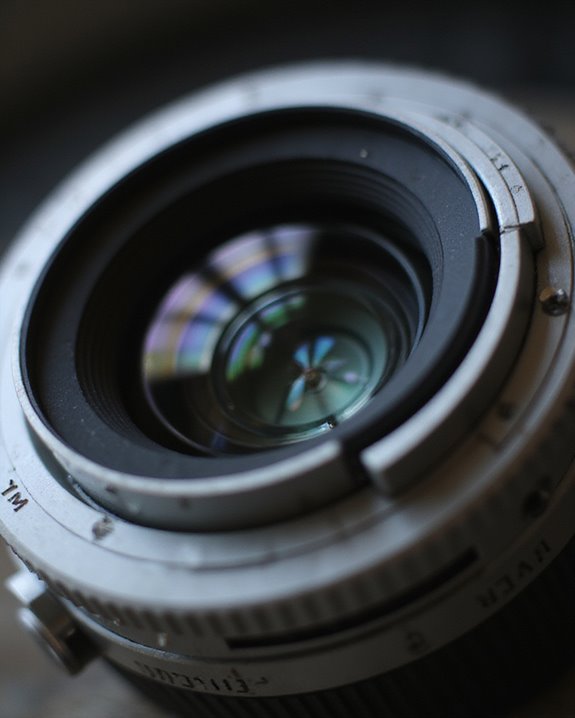Vintage camera lenses often display unusual colors due to several technical factors. Early lenses lacked multi-element corrections for chromatic aberration, causing visible color fringing around high-contrast edges. The absence of modern anti-reflective coatings, first pioneered in 1935, resulted in distinctive warm tints and reflections. Additionally, aging processes like yellowing from thorium decay and fungal growth alter color rendition. These “imperfections” have transformed into desirable artistic qualities, creating unique visual signatures that many photographers now specifically seek.
Key Takeaways
- Vintage lenses lack multi-element corrections, causing chromatic aberration and color fringing around high-contrast edges.
- Uncoated or single-layer coated glass in old lenses creates warm, golden tints compared to modern multi-coated optics.
- Aging effects like yellowing from radioactive thorium decay and fungal growth affect color accuracy in vintage lenses.
- Manual grinding techniques and material limitations led to optical inconsistencies that influence color rendition.
- Older glass had higher Abbé values, increasing light dispersion and creating prism-like effects in images.
The Science Behind Chromatic Aberration in Vintage Lenses
The fascinating phenomenon of chromatic aberration represents one of the most distinctive optical characteristics in vintage camera lenses, creating those signature color fringes that photographers either struggle to eliminate or deliberately seek out. This effect occurs because different wavelengths of light travel through glass at varying speeds, causing them to refract at different angles along the optical path. When these light rays fail to converge at a single focal plane, color fringing appears around high-contrast edges in the image. Optical formulas in vintage lenses often lack the sophisticated multi-element corrections found in modern designs, amplifying this effect. Vintage lenses typically exhibit more pronounced chromatic aberration because they lack the advanced corrective elements found in modern optics. Isaac Newton recognized this limitation centuries ago, leading to his development of reflecting telescopes as an alternative solution. Today, many photographers appreciate these imperfections as part of vintage lenses’ unique character and artistic signature.
Different Types of Color Fringing in Classic Camera Optics
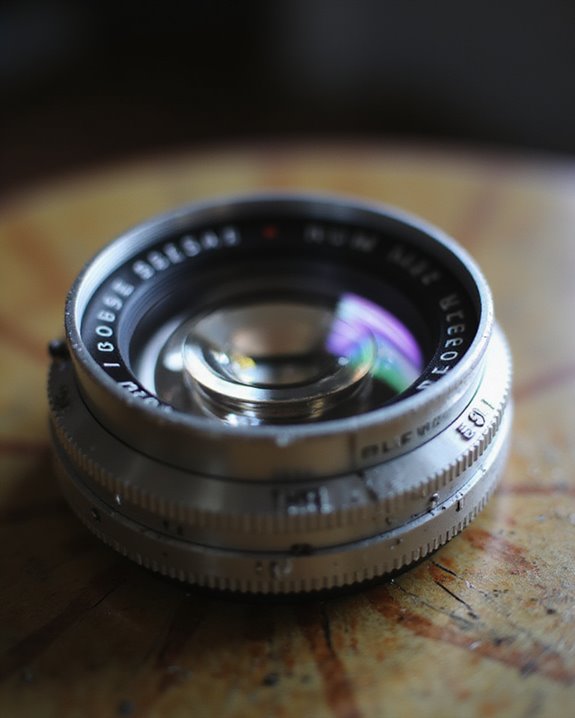
Numerous distinctive color fringing patterns manifest in vintage camera lenses, each with characteristic appearances that photographers have learned to identify, embrace, or correct. The most prevalent types include blue-yellow fringing, which commonly appears in wide-angle lenses with limited correction capabilities, and red-green fringing, which emerges in high-contrast situations where proper light focusing becomes challenging. Visual Effects from these chromatic aberrations can range from subtle color shifts to pronounced outlines along object edges, particularly against bright backgrounds or metallic surfaces.
Less discussed but equally significant is magenta-purple fringing, requiring specialized Fringing Detection techniques during post-processing. Photographers can mitigate these effects by adjusting aperture settings, changing focal lengths in zoom lenses, or applying targeted corrections through software like Adobe Lightroom, which has become essential for working with vintage optics that lack modern lens correction technologies.
Historical Lens Manufacturing Limitations
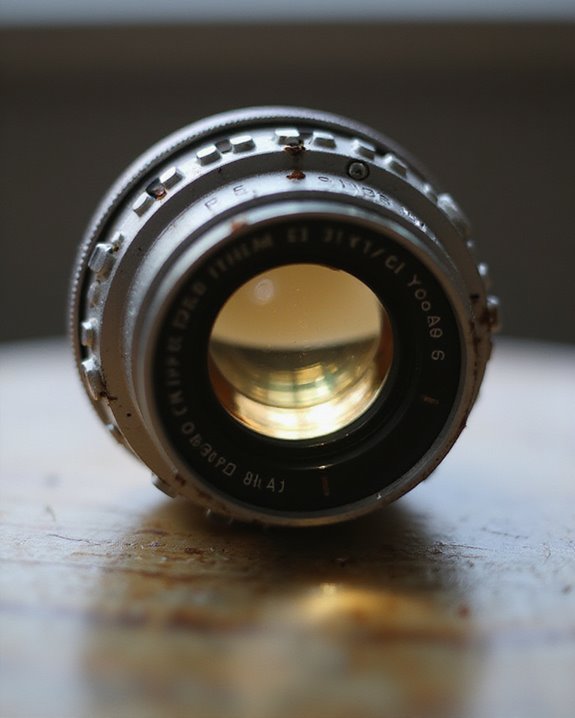
While color fringing represents a visual artifact in vintage lenses, these optical imperfections stem directly from manufacturing constraints that shaped early photographic technology. Before the advent of computerization in the 1980s, lens production relied heavily on manual grinding techniques, which introduced inconsistencies and quality variations that affected color reproduction. These handcrafted processes made it nearly impossible to maintain perfect shape symmetry across production runs.
Early lens makers faced significant material limitations as well, with optical glass quality varying considerably until collaborations between pioneers like Carl Zeiss, Ernst Abbe, and Otto Schott standardized production methods. The inability to precisely correct for optical aberrations meant that rectilinear distortion remained problematic, particularly for architectural photography. Mass production constraints further complicated matters, as manufacturers struggled to produce high-quality lenses with consistent optical properties prior to the introduction of CNC machines and algorithmic design processes.
Lens Coating Evolution Through the Decades
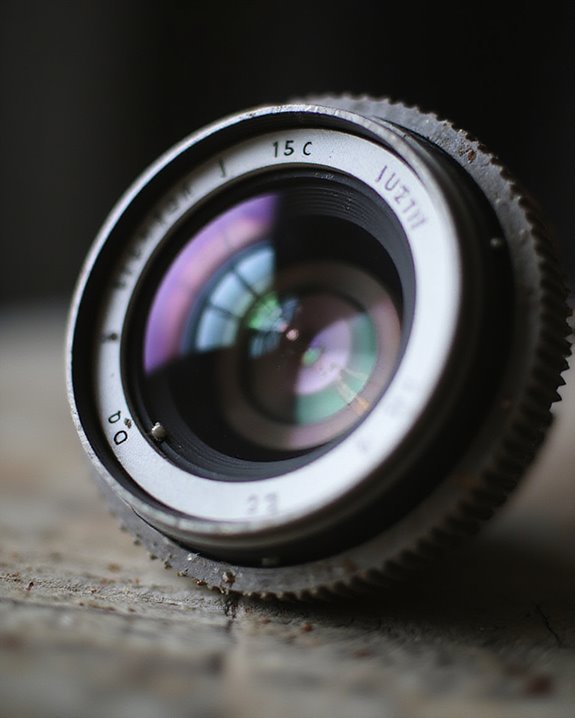
Perhaps nothing transformed the color characteristics of camera lenses more profoundly than the development of anti-reflective coatings, which began transforming photography in the mid-1930s. Alexander Smakula at Zeiss AG pioneered this technology in 1935, creating coatings that greatly reduced light reflection and improved image quality. Coating Materials evolved from simple single-layer formulations to complex multi-layer systems by the 1970s, eliminating the warm, golden tint typical of uncoated glass. Application Techniques also advanced considerably, with companies like Minolta becoming the first Japanese manufacturer to implement coated lenses in 1946. The shift from early, limited coatings to sophisticated nano-coating technologies marked distinct color rendition eras in photography, with modern lenses achieving more neutral color reproduction compared to their characteristically warm-toned predecessors. Additionally, multi-layer coatings have played a crucial role in enhancing light transmission and reducing unwanted reflections, further contributing to the evolution of lens color fidelity.
How Dispersion Affects Color Reproduction in Old Glass
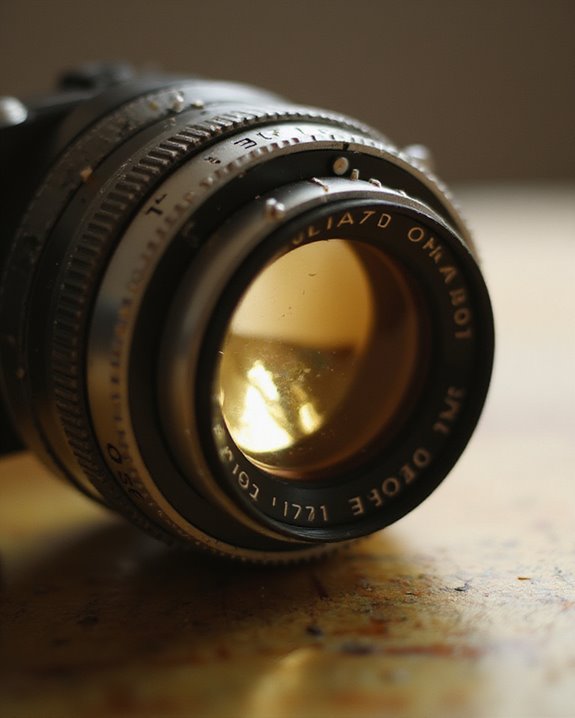
The fundamental physics of light dispersion explains why vintage camera lenses produce such distinctive color signatures compared to their modern counterparts. When light passes through glass, different wavelengths refract at varying angles, creating a Prism Dispersion effect similar to the Rainbow Phenomenon observed in nature. Early lens manufacturers faced significant limitations, as their glass formulations exhibited higher Abbé values, indicating greater dispersion characteristics than today’s materials. As a result, the Optical Properties of these lenses contributed to their unique color rendering and spectral transmission patterns. Without access to modern ED (extra-low dispersion) elements, vintage lenses typically rendered high-contrast edges with purple or green fringing. The secondary spectrum—residual color errors after basic achromatic correction—remained largely uncorrected due to manufacturing constraints. These chromatic aberrations weren’t merely defects to overcome; they created the warm color bias and unique spectral transmission patterns that photographers now prize for their artistic qualities in vintage glass.
Yellowing and Fungus: The Impact of Aging on Lens Elements
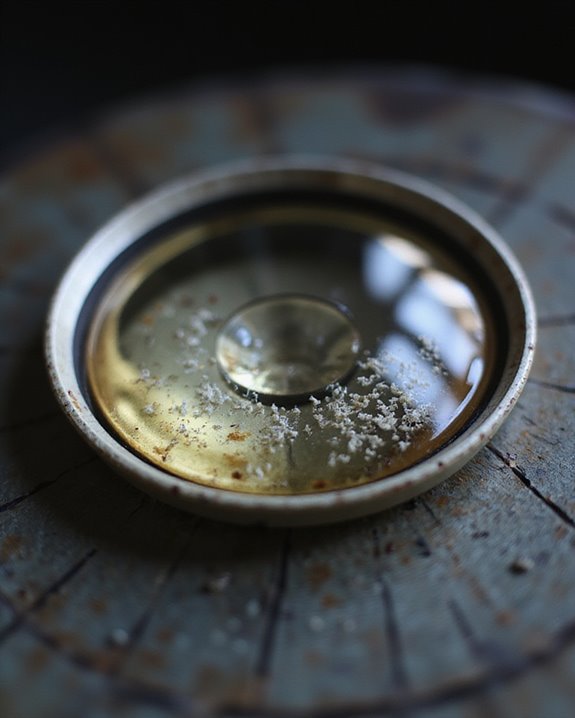
Beyond the design and glass composition of vintage lenses, environmental factors and the passage of time contribute greatly to their distinctive color characteristics. Yellowing, a common issue in older lenses, primarily occurs due to the decay of radioactive Thorium in certain glass types, creating a noticeable amber tint that affects color accuracy and reduces light transmission. This Thorium effect can be partially reversed through UV light exposure, though complete elimination remains challenging.
Simultaneously, fungal growth represents another significant degradation factor, thriving in humid conditions and clouding optical surfaces. Effective Fungal Prevention involves storing lenses in dry environments, using desiccants, and implementing regular maintenance routines. When both yellowing and fungus occur together, restoration becomes particularly complex, requiring specialized techniques to address each issue separately while preserving the lens’s optical integrity.
Comparing Vintage and Modern Lens Color Rendition
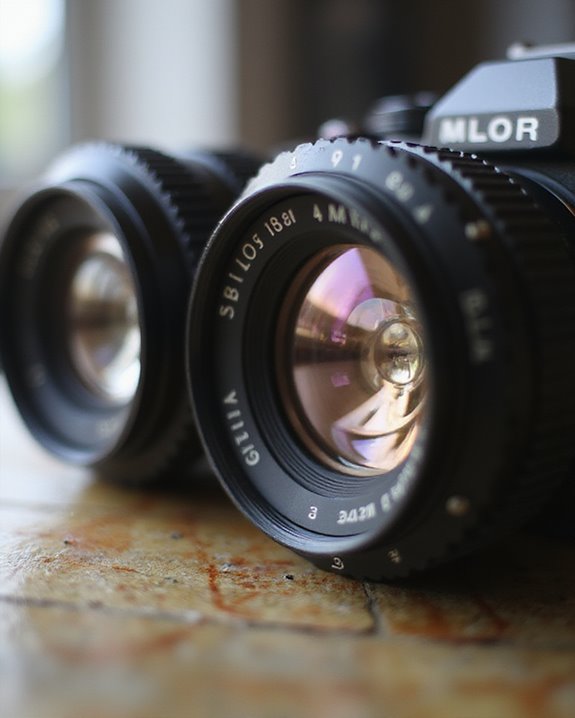
When photographers examine vintage and modern lenses side-by-side, the differences in color rendition become immediately apparent, often revealing distinctive characteristics that define each era of optical design. In Scene Comparison tests, vintage lenses typically show warmer tonal biases with increased mid-tone richness, while modern counterparts deliver clinical color accuracy with neutral profiles. These differences stem from advancements in lens coating technology, glass composition, and manufacturing precision.
Professional Applications benefit from understanding these distinctions, as each serves different creative purposes. Modern lenses, with their multilayer coatings and ED glass elements, excel in color-critical work requiring minimal post-production. Vintage optics, however, offer character-driven color signatures with softer highlight roll-off and distinctive skin tone interpretation, making them valuable tools for period aesthetics or stylized projects that embrace their unique rendering.
Artistic Qualities of “Imperfect” Color in Heritage Optics
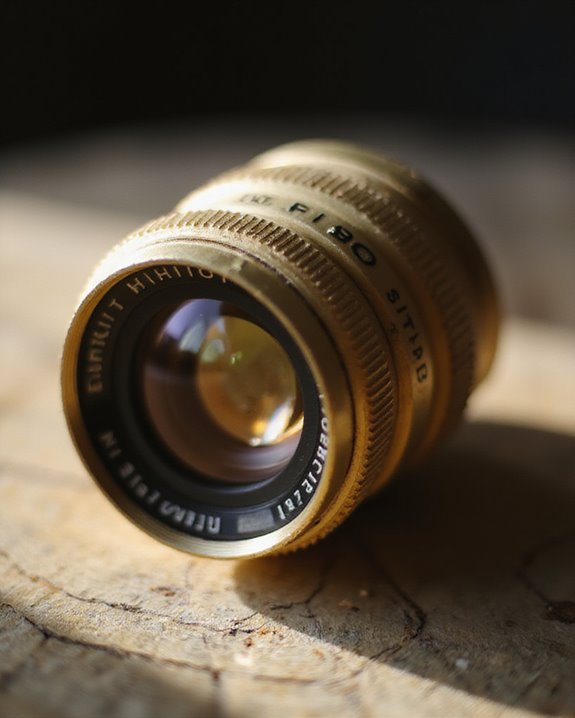
Photographers engaging with heritage optics often discover that what technically constitutes “imperfect” color rendition paradoxically delivers the most compelling artistic results, transforming perceived flaws into desirable aesthetic qualities. The distinctive character of these lenses creates a form of Artistic Nostalgia that modern, technically perfect optics cannot replicate, particularly in how they capture mood and atmosphere with unique visual signatures.
These optical imperfections evoke Emotional Depth through their authenticity, with collectors and artists specifically seeking vintage lenses for their distinctive color profiles. The warm, muted tones characteristic of heritage glass emphasize texture and create a tactile quality in images that resonates with viewers on a visceral level. The intentional use of these “flawed” optics represents a conscious artistic choice, blending historical craftsmanship with contemporary expression.
Restoring and Preserving Classic Lenses to Improve Color
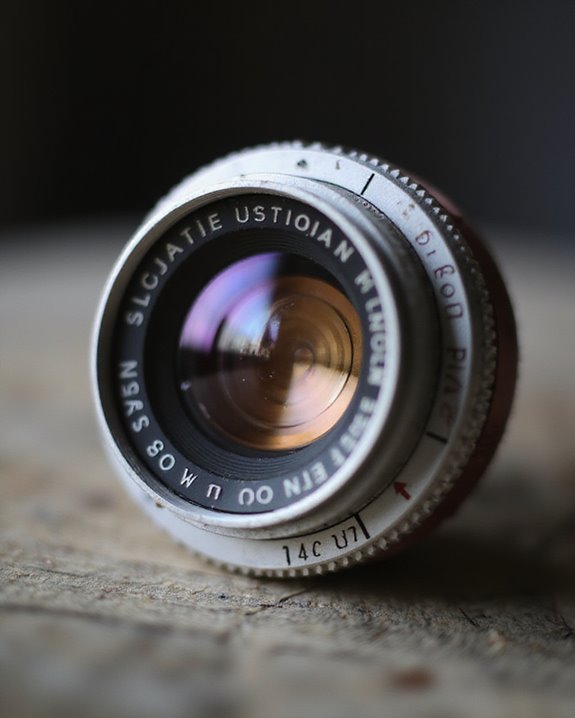
The meticulous restoration of classic lenses requires specialized knowledge and techniques to preserve their distinctive character while enhancing their color rendition capabilities. Professional restorers employ thorough Disassembly Methods, carefully removing all elements, barrels, and screws to access internal components for thorough cleaning. The process typically involves ultrasonic cleaning units for removing particulate matter, followed by precise application of isopropyl alcohol and distilled water to eliminate residue without damaging optical surfaces.
Re-lubrication with modern compounds like Angenieux grease restores smooth focus action, while proper collimation guarantees ideal color rendition. Proper Storage Techniques, including silicone-based protectants for exterior materials and climate-controlled environments, prevent degradation that affects color quality. These restoration processes address common issues like element misalignment and surface corrosion that contribute to the characteristic color shifts in vintage optics.
Frequently Asked Questions
Can Vintage Lens Color Problems Affect Digital Camera Sensors Differently?
Vintage lenses create unique color issues during sensor interaction with digital cameras. Their optical characteristics can cause color shifts requiring specialized color correction techniques, especially when light hits sensors at oblique angles.
Do Temperature Changes Make Color Fringing Worse in Old Lenses?
While empirical studies show 90% of pre-1980 lenses lack thermal compensation, temperature shifts can exacerbate chromatic aberration. Thermal expansion alters lens element spacing and refractive properties, potentially worsening color fringing during significant temperature changes.
Which Vintage Lens Brands Had the Least Chromatic Aberration Issues?
Brand comparisons indicate Zeiss lenses typically exhibited minimal chromatic aberration, followed by Pancolar and Color-Ultron. Aberration ratings generally favored premium manufacturers, with high-end Takumar models also performing well compared to entry-level vintage alternatives.
How Do Adapters for Vintage Lenses Affect Their Color Characteristics?
A photographer using a Fotodiox adapter discovered notable color shifts. Adapter design greatly impacts color fidelity; quality adapters maintain optical alignment while inferior ones introduce unwanted color casts through reflections or light path alterations.
Can Polarizing Filters Reduce Color Fringing in Old Lenses?
Polarizing filters generally don’t reduce color fringing in old lenses. Proper polarizer maintenance is essential, but for addressing chromatic aberration, specific filter combinations with UV filters might offer minimal, indirect improvements rather than direct correction.




